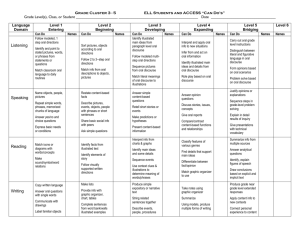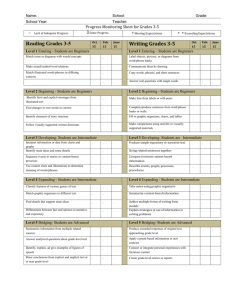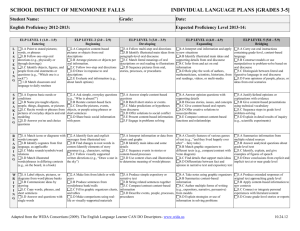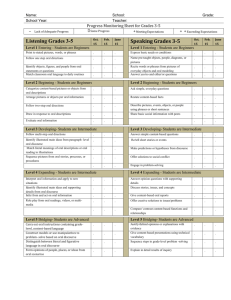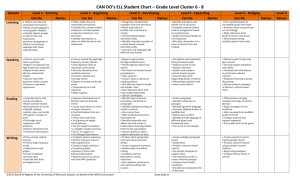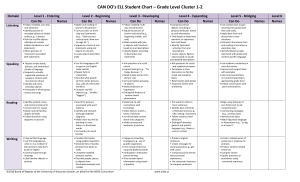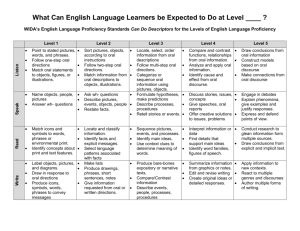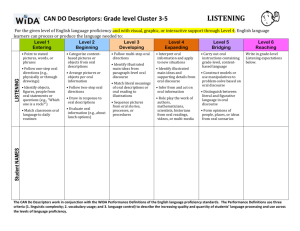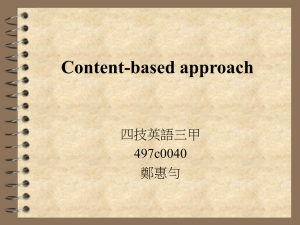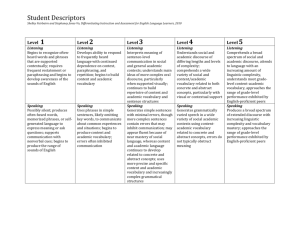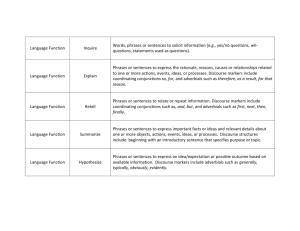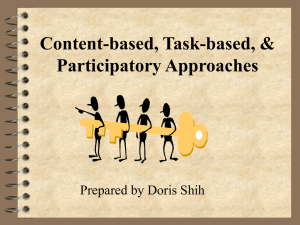CAN DO`s ELL Student Chart – Grade Level Cluster 3-5
advertisement
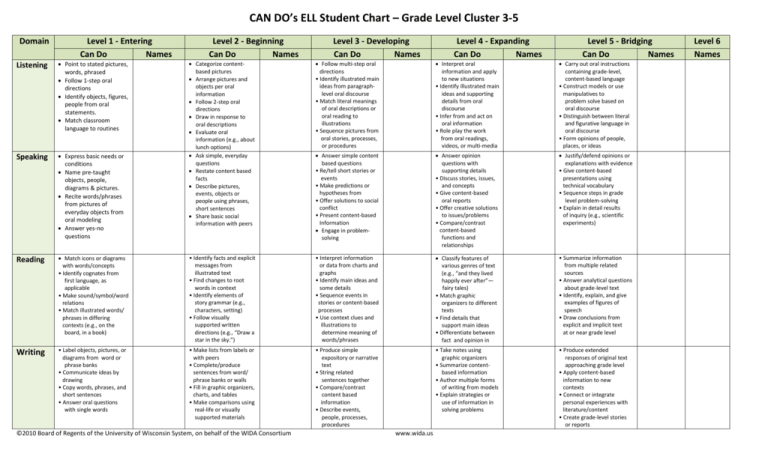
CAN DO’s ELL Student Chart – Grade Level Cluster 3-5 Domain Level 1 - Entering Can Do Names Level 2 - Beginning Can Do Names Level 3 - Developing Can Do Names Level 4 - Expanding Can Do Names Level 5 - Bridging Can Do Names Categorize contentbased pictures Arrange pictures and objects per oral information Follow 2-step oral directions Draw in response to oral descriptions Evaluate oral information (e.g., about lunch options) Ask simple, everyday questions Restate content based facts Describe pictures, events, objects or people using phrases, short sentences Share basic social information with peers Follow multi-step oral directions • Identify illustrated main ideas from paragraphlevel oral discourse • Match literal meanings of oral descriptions or oral reading to illustrations • Sequence pictures from oral stories, processes, or procedures Interpret oral information and apply to new situations • Identify illustrated main ideas and supporting details from oral discourse • Infer from and act on oral information • Role play the work from oral readings, videos, or multi-media Carry out oral instructions containing grade-level, content-based language • Construct models or use manipulatives to problem solve based on oral discourse • Distinguish between literal and figurative language in oral discourse • Form opinions of people, places, or ideas Answer simple content based questions • Re/tell short stories or events • Make predictions or hypotheses from • Offer solutions to social conflict • Present content-based Information Engage in problemsolving Answer opinion questions with supporting details • Discuss stories, issues, and concepts • Give content-based oral reports • Offer creative solutions to issues/problems • Compare/contrast content-based functions and relationships Justify/defend opinions or explanations with evidence • Give content-based presentations using technical vocabulary • Sequence steps in grade level problem-solving • Explain in detail results of inquiry (e.g., scientific experiments) Match icons or diagrams with words/concepts • Identify cognates from first language, as applicable • Make sound/symbol/word relations • Match illustrated words/ phrases in differing contexts (e.g., on the board, in a book) • Identify facts and explicit messages from illustrated text • Find changes to root words in context • Identify elements of story grammar (e.g., characters, setting) • Follow visually supported written directions (e.g., “Draw a star in the sky.”) • Interpret information or data from charts and graphs • Identify main ideas and some details • Sequence events in stories or content-based processes • Use context clues and illustrations to determine meaning of words/phrases Classify features of various genres of text (e.g., “and they lived happily ever after”— fairy tales) • Match graphic organizers to different texts • Find details that support main ideas • Differentiate between fact and opinion in • Summarize information from multiple related sources • Answer analytical questions about grade-level text • Identify, explain, and give examples of figures of speech • Draw conclusions from explicit and implicit text at or near grade level • Label objects, pictures, or diagrams from word or phrase banks • Communicate ideas by drawing • Copy words, phrases, and short sentences • Answer oral questions with single words • Make lists from labels or with peers • Complete/produce sentences from word/ phrase banks or walls • Fill in graphic organizers, charts, and tables • Make comparisons using real-life or visually supported materials • Produce simple expository or narrative text • String related sentences together • Compare/contrast content based information • Describe events, people, processes, procedures • Take notes using graphic organizers • Summarize contentbased information • Author multiple forms of writing from models • Explain strategies or use of information in solving problems • Produce extended responses of original text approaching grade level • Apply content-based information to new contexts • Connect or integrate personal experiences with literature/content • Create grade-level stories or reports Listening Point to stated pictures, words, phrased Follow 1-step oral directions Identify objects, figures, people from oral statements. Match classroom language to routines Speaking Express basic needs or conditions Name pre-taught objects, people, diagrams & pictures. Recite words/phrases from pictures of everyday objects from oral modeling Answer yes-no questions Reading Writing ©2010 Board of Regents of the University of Wisconsin System, on behalf of the WIDA Consortium www.wida.us Level 6 Names
